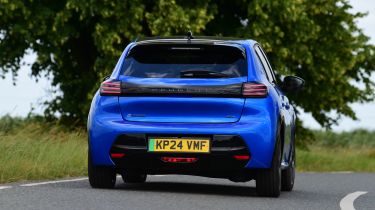Peugeot 208 - Interior, design and technology
The Peugeot 208 looks great and includes lots of tech, but you’ll certainly pay for it

The Peugeot 208 has been designed to charm a new generation of customers. Inside and out, the approach is eye-catching, and the quality of the interior is equally impressive.
Aside from some hard plastics on the doors and glovebox lid, along with the piano black plastic that seems to highlight every fingerprint and light scratch, the dashboard has plenty of soft-touch materials, and it feels well put together. There are also many nice design details, like contrast stitching and configurable ambient lighting.
The latest 208 uses a revised version of Peugeot’s i-Cockpit set-up, but we still think it won’t suit everyone. Rather than looking through the steering wheel, the 208 has a much smaller wheel you must look over to see vital information, like your speed. We recommend you try the set-up for yourself to ensure you can find a comfortable driving position and still see all the info on the dash.
It’s also worth noting that entry-level Active models get an ordinary set of analogue dials for the driver’s display, but Allure trim and above use a fully digital instrument panel. It works well, and you can change the layout of the display from traditional dials to showing various trip or driving assistance screens, or directions on a map if you've specified the optional navigation system.
Used - available now
This digital display is similar (in theory) to Audi’s Virtual Cockpit, which is available in the Audi A1. Switching between screens in the 208 isn’t as easy as in an Audi, and some people may find the layout takes a bit of getting used to.
The cheapest Active specification includes 16-inch steel wheels with covers, an alarm, automatic lights and wipers, climate control, Bluetooth, a DAB radio, rear parking sensors, and a basic driver instrument cluster.
Upgrading to mid-range Allure trim adds a 10-inch central touchscreen with Apple CarPlay and Android Auto smartphone connectivity, front parking sensors, an auto-dimming rearview mirror, privacy glass and an acoustic windscreen to reduce noise.
Finally, the top-of-the-range GT spec includes 17-inch alloy wheels, upgraded LED headlights, eight-colour ambient lighting, plus a 180-degree colour reversing camera. Optional extras offered on GT models include adaptive cruise control, blind spot monitoring and a panoramic glass roof.
Sat-nav, stereo and infotainment
All models receive Bluetooth, a DAB radio, a 10-inch touchscreen with wireless Apple CarPlay and Android Auto smartphone connectivity, and a six-speaker sound system. Move up to mid-range Allure, and you can choose a wireless phone charging pad (that comes as standard on the GT model) as an option. The top-of-the-range GT gets an HD screen that looks especially snazzy but doesn’t improve its useability. Like the rest of the range, it can be fiddly to use, and is nowhere near as simple to navigate, or as quick to load as the systems in rivals like the SEAT Ibiza and Volkswagen Polo.
No version of 208 or E-208 comes with sat-nav as standard; that’ll need to be added as an option. Even then, you only get a six-month trial of live traffic information, speed camera locations, weather conditions, fueling stations, and points of interest. You’ll need to take out a subscription if you want to keep it after the trial period expires.












